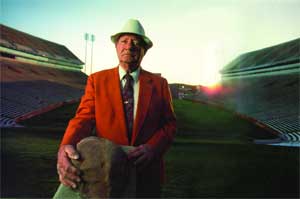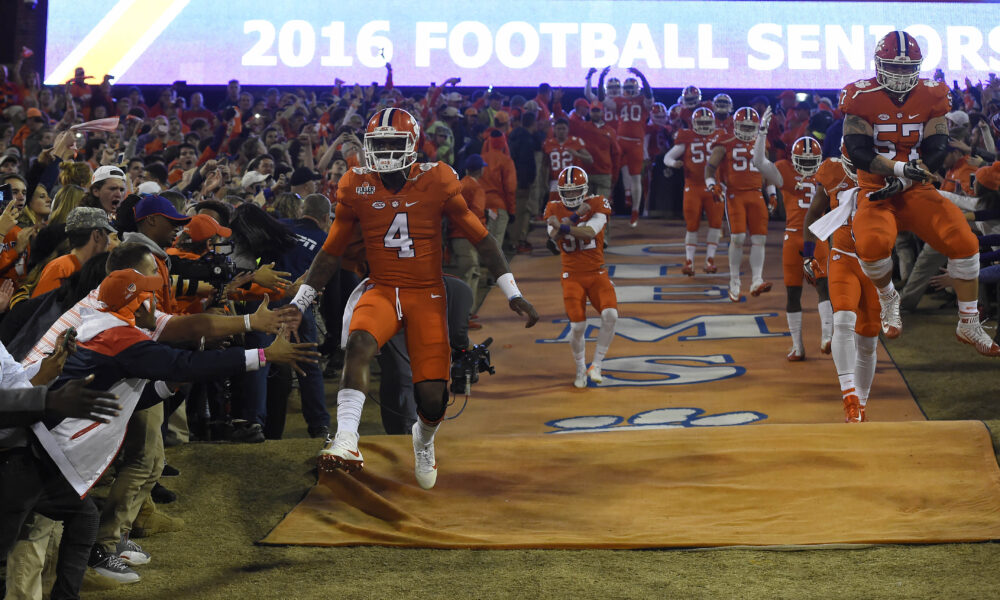Football is a way of life in Clemson, S.C.
Clemson has played America’s favorite sport for all but three years since it opened its doors in 1893. Through the years, Clemson traditionally has been one of college football’s most consistent teams with three national championships, 24 conference titles and 44 bowl appearances.
The stories, legendary coaches and traditions at Clemson make up some the of the best in the sport.
No tradition or story is better at Clemson than the tradition of Howard’s Rock, especially with how it started.
When Memorial Stadium opened its doors in 1942, the football team’s dressing room was located at old Fike Fieldhouse, down the street on Williamson Road on the east side of the stadium. The Tigers would dress at Fike and then take the short walk down Williamson Road to the stadium.
From the first day the gates opened to Memorial Stadium, prior to warmups, Howard had his team enter through the east side gate where they would run down the hill instead of walking around. It was a tradition that was born out of convenience more than anything else.
At first, there was no carpet for the players to run down. There was no band playing Tiger Rag. There were no fans. It was just the team running down the hill to do warmups. It was not really that special.
However, eventually fans started showing up a little bit earlier each home game and would cheer the Tigers on as they came down the hill. Over the years the crowds grew from a few people to a few hundred.
In the late 1950s, Clemson alum S.C. Jones was driving through Death Valley, California when he stopped his car and picked up a 10-pound rock and put it in his trunk. He carried the rock all the way back to Clemson, where Memorial Stadium had already taken on the moniker Death Valley.
Jones thought it would be nice for Clemson’s Death Valley to have a rock from the real Death Valley in California. Howard accept the gift and then placed it his office where it sat on the floor for nearly seven years.
Legend has it that Howard used the rock as a door stop and when he began to clean his office one day in the spring of 1966, he decided he did not want it anymore. The long-time Clemson coach told Gene Willimon, the executive secretary of IPTAY at the time, to get rid of the rock. He suggested to Willimon to toss it over in the Valley with the rest of the rocks around the stadium.

Frank Howard with his rock in 1989. Howard told his players that his rock had mystical powers. (File Photo/Clemson Athletic Communications)
Willimon did not think that was such a nice thing to do since Jones went out of his way to bring Howard this rock from Death Valley, California. So, without telling Howard, he placed the rock at the top of the east hill on a pedestal under the scoreboard.
It was in place in time for the opening game of the 1966 season as the Tigers hosted Virginia. The Cavaliers went up by 18 points, 28-10, on the Tigers by the end of the third quarter and looked as if they would get their first ever win over a Clemson team.
However, the Tigers rallied for one of the greatest comebacks in Death Valley history and won the game, 40-35. Clemson went on to an undefeated season that year in Death Valley, giving birth to Howard’s tale of how his rock has “mystical powers.”
Howard figured he could use this tale to his advantage.
At dinner, the Friday night before the Tigers’ 1967 season-opener against Wake Forest, Howard told his team, “Lockie here, boys. If any of you boys are gonna go out and give me 120 percent, I’ll let you rub my rock; and it’ll give you supernatural powers,” Howard said in the book The Clemson Tigers: From 1896 to Glory.
His players promised they would and the next day they rubbed Howard’s Rock, ran down the hill and beat Wake Forest, 23-6. The Legend of Howard’s Rock was born.
Clemson players have since touched Howard’s Rock and run down the hill 402 times.
These days, thanks to former head coach Red Parker’s creativeness prior to the Texas A&M game in 1973, Clemson leaves the locker room about 10 minutes before kickoff under the WestZone of Memorial Stadium. The team boards a group of buses, which carries them to the top of the east side of the stadium, where they charge down the hill and into Death Valley.
In 1985, against Georgia, then CBS announcer Brent Musburger, described the Tigers’ charging down the hill as “the most exciting 25 seconds in college football.”
